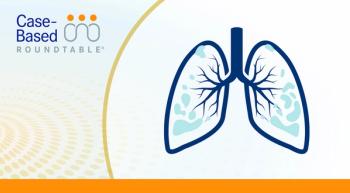
Peers & Perspectives in Oncology
- May 2024
- Volume 2
- Issue 7
- Pages: 79
Carrizosa Explores Trials of Immunotherapy in Extensive-Stage Small Cell Lung Cancer

In an in-person Community Case Forum event in partnership with the North Carolina Oncology Association and South Carolina Oncology Society, Daniel Carrizosa, MD, MS, discussed the use of the immunotherapies durvalumab and atezolizumab in patients with small cell lung cancer.
PEERS & PERSPECTIVES IN ONCOLOGY: What do the National Comprehensive Cancer Network guidelines recommend as treatment for ES-SCLC with no prior systemic therapy?
CARRIZOSA: We have 2 FDA-approved immunotherapies, atezolizumab [Tecentriq] and durvalumab [Imfinzi]. For the patients who are not immunotherapy candidates, we have what we classically had a decade ago.1 If you’re in Japan, you can give [carboplatin or cisplatin plus] irinotecan because they had good data for that.2 [Although] that did not pan out as much here in the United States, it is still an option, but I don’t know how many [patients with those] certain circumstances we’re looking at. Some patients may see up to 6 cycles [of chemotherapy rather than 4 cycles based on response and tolerability].1
What data support the use of atezolizumab in patients with ES-SCLC?
The phase 3 IMpower133 study [NCT02763579] is the atezolizumab study. We [compared] the standard carboplatin-etoposide vs carboplatin, etoposide, and atezolizumab with atezolizumab maintenance, and then patients were treated until progressive disease. Percutaneous cranial radiation was allowed per local standard of care, and the co–primary end points were overall survival [OS] and investigator-assessed progression-free survival [PFS].
The Kaplan-Meier curve [for PFS shows] we have a nice tail for the atezolizumab, and looking at the PFS at 6 and 12 months, there is a statistical difference [stratified HR, 0.77; 95% CI, 0.62-0.96] and the P value was .02.3,4 I think [we] were happy that we had another option, but I know [we] were also somewhat disillusioned with the fact that even though we have a tail, the tail is low. OS is why it got approved, and we have an OS benefit. Looking at 12 and 18 months, we still see that benefit, and the HR is 0.76 [95% CI, 0.60-0.95] with a significant P value [.0154], and the median follow-up in the study was 22.9 months.4 So [there was] benefit, and the question would be how absolute the benefit is and [the] cost.
Would you stop treating patients with immunotherapy at 2 years, particularly if they show no evidence of disease (NED)?
It’s a bit easier but [still requires] discussion with the patient if they have NED. Because [if I] don’t see anything, maybe I feel a bit better about it. Most of my patients don’t want to stop because they’re terrified of [the possibility that] it’s going to come back. Then the question is, “If it comes back, am I going to respond?” And I have to [say], “Probably, but I can’t tell you definitely.” That’s a hard discussion.
The problem is, I am starting to see insurance companies say that patients have had 2 years of therapy, so they are not going to pay for more. Then the patient says, “I’ll pay for it.” And I [tell them] how much it is, and then they [say], “Oh, I can’t do that.” So I have that balanced discussion. If the insurance is going to let it [continue], the hard part is we know that the immune-related adverse events [AEs] of immune checkpoint inhibitors happen at any time. If you are on year 3 or year 4, you still have that risk of getting colitis, pneumonitis, [etc], unlike when you’ve [received] chemotherapy and you’ve gotten through that possible infusion reaction at the beginning and some of those other AEs. You [must] be counseling them that they still have risk. But I think when you’re sitting in the chair, that’s a hard sell. [If] I’m on a medicine that’s keeping me going after [the oncologist] told me I was going to die, and it’s working, why would I stop?
Look at melanoma. There, they’re stopping therapy even sooner, because patients are having a complete response. All the lung indications technically for non–small cell lung cancer are [stopping at] 2 years. Look at all the studies: at 2 years, they are stopping the immunotherapy and continuing the add-on. So, it becomes hard. But I’m sitting in the [infusion] chair, and I’m feeling good; I want to keep going on the medicine. All of us are inherently scared of this. SCLC is something that we just don’t like seeing, so we all are going to be as worried as the patient [about] stopping.
What other results were observed from IMpower133?
In the subgroup analysis, everything was [favoring atezo-lizumab], other than the question of brain metastasis, which might have been closer [HR, 0.96; 95% CI, 0.46-2.01], but that’s a small number, 35 patients.4 I don’t think you can take a lot out of that. [The percentage of] patients with ongoing response for 2 years was 9% [with atezolizumab] vs 2.3% with placebo. There is obviously a difference [although] it was not a great number of patients: 11 vs 3, [respectively].5 This is bringing back the point that this is unfortunately one of those diseases that we have to be very honest with our patients that this is not a great cancer to have; we don’t have a lot of options.
[In terms of] AEs, the carboplatin-etoposide causes a lot of cytopenias, but we’re looking at all the immune-related AEs [with atezolizumab]. Looking at grade 5, we don’t see much of any AE; there were 3 [in each arm], so overall it was very well tolerated.3
What were the outcomes of the trial of durvalumab in this setting?
The other study was the phase 3 CASPIAN study [NCT03043872], which is the durvalumab study. This was a 3-arm study that had a [chemotherapy plus] durvalumab plus tremelimumab [Imjudo] arm vs durvalumab [plus chemotherapy]. [The chemotherapy was] etoposide plus platinum, and that’s a difference [from IMpower133].
Patients could either get carboplatin or cisplatin. The primary end point was OS. [It was] updated as 3 years’ OS.6 We have longer data on durvalumab compared with atezolizumab. Again, looking at the tail, there were not huge differences, but there is a statistical difference between the 2 arms [favoring durvalumab with an HR of 0.71; 95% CI, 0.60-0.88; nominal P = .0003]. We are not looking at the durvalumab/ tremelimumab arm that did not [show benefit].7 In the subgroup analysis, everything was favoring durvalumab and looking at some of these areas, [such as] age differences, brain metastases, and stage III [disease], there were small numbers.6
For the updated PFS in the intent-to-treat population, again, we saw a nice split after 9 months and a nice tail of the [Kaplan-Meier] curve [HR, 0.80; 95% CI, 0.66-0.96; not formally tested for significance].7 Looking at 24 months, there was an 11% probability of PFS with durvalumab vs 2.9% [with chemotherapy alone]. So, this was another study showing benefit. [It’s] better than nothing, and at least there is something available.
Objective response also was positive for the durvalumab arm. [Like IMpower133], at 2 years 13.5% [had an ongoing response with durvalumab] vs 3.9% [with chemotherapy].8
We know what immunotherapy does [in terms of tolerability]. What we see is not necessarily an exponential worsening of AE with the combination; just the addition of immunotherapy-related AEs. Looking at greater than grade 3 AEs, [we are not concerned with] the durvalumab/tremelimumab arm [because] we know the CTLA-4 always causes more AEs from the immune perspective. But looking at grade 3/4 AEs between the durvalumab and the nondurvalumab arm, there is not much difference [Table9]. There was not much difference in serious AEs. This was a relatively safe therapy.
What practical considerations are there with the use of durvalumab or atezolizumab for patients with ES-SCLC?
[In terms of] differences between the 2 therapies, the studies had differences in what platinum agents you could get. For dosage administration, atezolizumab has very different dosages between every 2 weeks [840 mg], every 3 weeks [1200 mg], and every 4 weeks [1680 mg].10 Durvalumab has the 1500-mg dose [given every 3 weeks] and the same 1500-mg dose every 4 weeks [as a single agent].11 Durvalumab has better data in the population [weighing less than 30 kg]. We are looking at the same types of warnings and precautions [for immune-related AEs, infusion-related reactions, allogeneic stem cell transplant complications, and embryo-fetal toxicity].
REFERENCES:
1. NCCN. Clinical Practice Guidelines in Oncology. Small cell lung cancer, version 2.2024. Accessed April 12, 2024. https://tinyurl.com/9tvae44j
2. Okamoto H, Watanabe K, Kunikane H, et al. Randomised phase III trial of carboplatin plus etoposide vs split doses of cisplatin plus etoposide in elderly or poor-risk patients with extensive disease small-cell lung cancer: JCOG 9702. Br J Cancer. 2007;97(2):162-169. doi:10.1038/sj.bjc.6603810
3. Horn L, Mansfield AS, Szczęsna A, et al; IMpower133 Study Group. First-line atezolizumab plus chemotherapy in extensive-stage small-cell lung cancer. N Engl J Med. 2018;379(23):2220-2229. doi:10.1056/NEJMoa1809064
4. Liu SV, Reck M, Mansfield AS, et al. Updated overall survival and PD-L1 subgroup analysis of patients with extensive-stage small-cell lung cancer treated with atezolizumab, carboplatin, and etoposide (IMpower133). J Clin Oncol. 2021;39(6):619-630. doi:10.1200/JCO.20.01055
5. Reck M, Liu SV, Mansfield AS, et al. IMpower133: updated overall survival (OS) analysis of first-line (1L) atezolizumab (atezo) + carboplatin + etoposide in extensive-stage SCLC (ES-SCLC). Ann Oncol. 2019;30(suppl 5):v710-v711 doi:10.1093/annonc/mdz264
6. Paz-Ares L, Chen Y, Reinmuth N, et al. Durvalumab, with or without tremelimumab, plus platinum-etoposide in first-line treatment of extensive-stage small-cell lung cancer: 3-year overall survival update from CASPIAN. ESMO Open. 2022;7(2):100408. doi:10.1016/j.esmoop.2022.100408
7. Goldman JW, Dvorkin M, Chen Y, et al; CASPIAN investigators. Durvalumab, with or without tremelimumab, plus platinum-etoposide versus platinum-etoposide alone in first-line treatment of extensive-stage small-cell lung cancer (CASPIAN): updated results from a randomised, controlled, open-label, phase 3 trial. Lancet Oncol. 2021;22(1):51-65. doi:10.1016/S1470-2045(20)30539-8
8. Paz-Ares LG, Dvorkin M, Chen Y, et al. Durvalumab ± tremelimumab + platinum-etoposide in first-line extensive-stage SCLC (ES-SCLC): updated results from the phase III CASPIAN study. J Clin Oncol. 2020;38(suppl 15):9002. doi:10.1200/JCO.2020.38.15_suppl.9002
9. Paz-Ares L, Dvorkin M, Chen Y, et al; CASPIAN investigators. Durvalumab plus platinum-etoposide versus platinum-etoposide in first-line treatment of extensive-stage small-cell lung cancer (CASPIAN): a randomised, controlled, open-label, phase 3 trial. Lancet. 2019;394(10212):1929-1939. doi:10.1016/S0140-6736(19)32222-6
10. Tecentriq. Prescribing information. Genentech; 2022. Accessed April 12, 2024. https://tinyurl.com/252wftda
11. Imfinzi. Prescribing information. AstraZeneca; 2022. Accessed April 12, 2024. https://tinyurl.com/2b86aj9p
Articles in this issue
over 1 year ago
Roundtable Roundup: Challenges of Treating Myelofibrosis







































